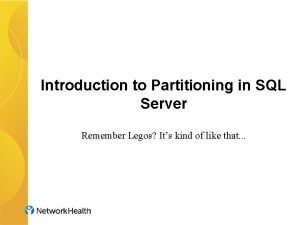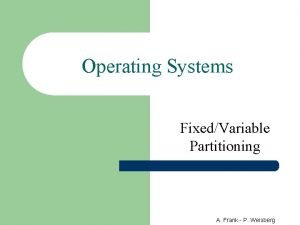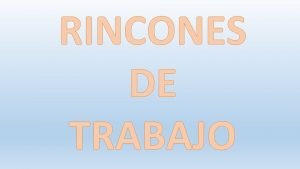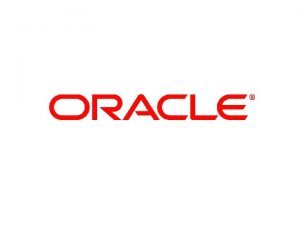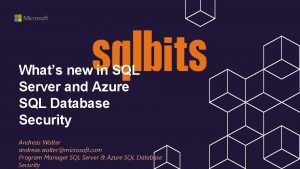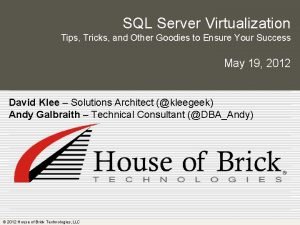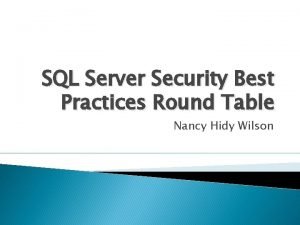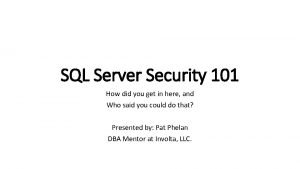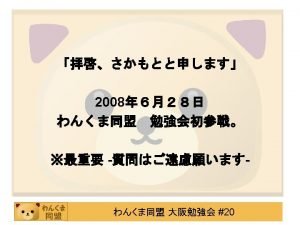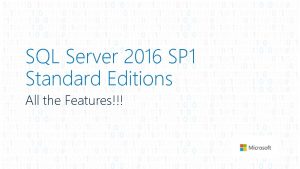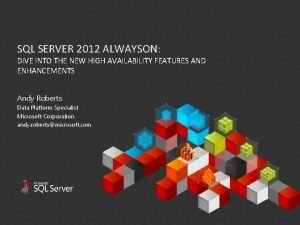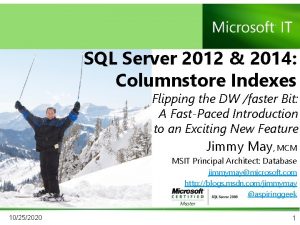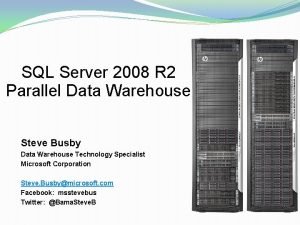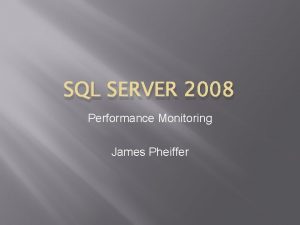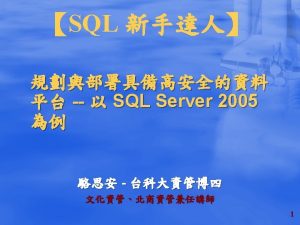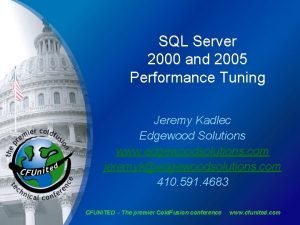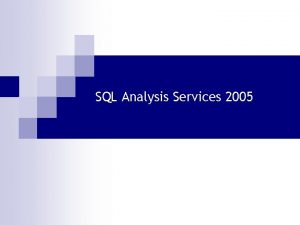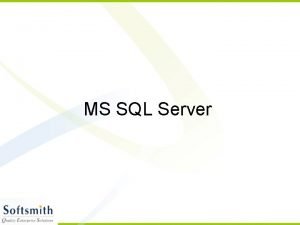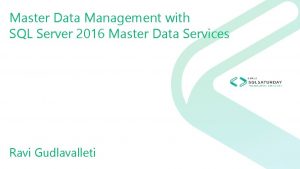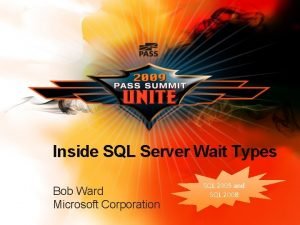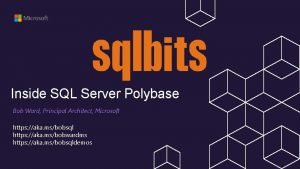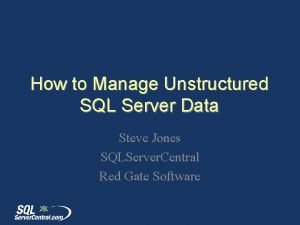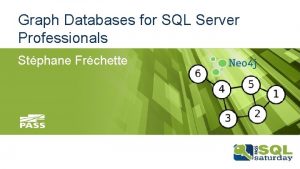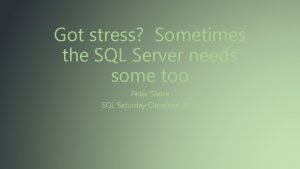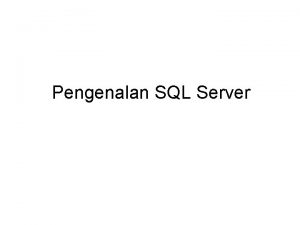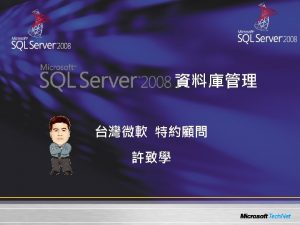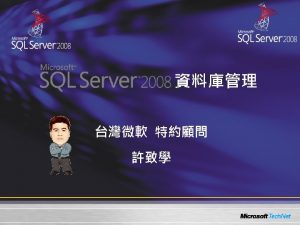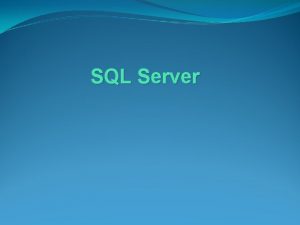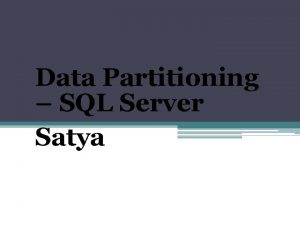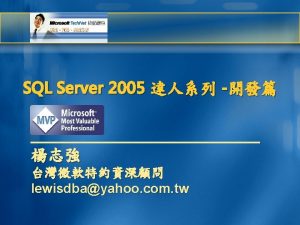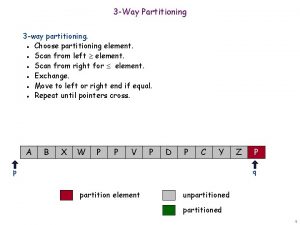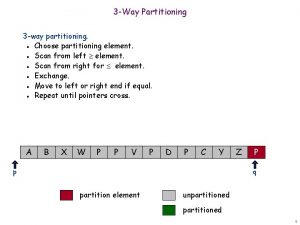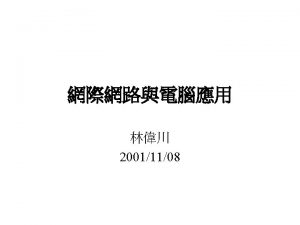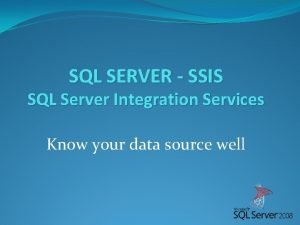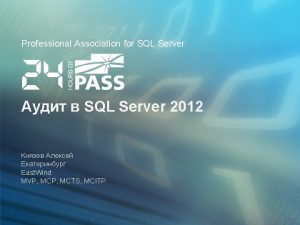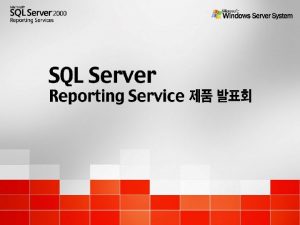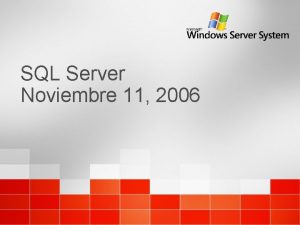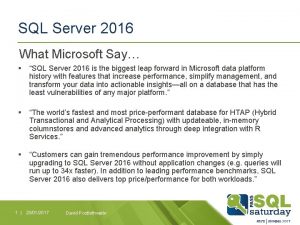Partitioning techniques in SQL Server Eladio Rincon ERinconsolidq






































- Slides: 38

Partitioning techniques in SQL Server Eladio Rincon (ERincon@solidq. com) Javier Loria (javier@solidq. com) Solid Quality Mentors

Agenda Why? How? What? Where? Partitioning Toolbox © 2008 Solid Quality Mentors 2

Agenda Why? • • Definition I/O Basics Table Basics Operational Benefits How? What? Where? Toolbox © 2008 Solid Quality Mentors 3

Definition Physical segregation of a single logical table name into multiple, identical physical structures © 2008 Solid Quality Mentors 4

I/O Basics Operation File SELECT Database Random INSERT UPDATE DELETE Log Bulk Insert Database Random Full Backup Database Sequential Synchronous * Log Backup Log Synchronous - Read ? ? Sequential Database Random Reindex 8 Type OLTP 8 x 5 © 2008 Solid Quality Mentors Sequential Random 24 Write Synchronous - - Synchronous - Asynchronous 8 24 8 2 4 S Synchronous OLTP 24 x 7 S 2 4 S S 2 4 OLAP 5

Table Basics © 2008 Solid Quality Mentors 6

Operational Benefits Performance Availability Bulk. Insert (OLAP) Full Backups Query (OLPT/OLAP) © 2008 Solid Quality Mentors Maintainability Archiving Pruning Reindex 7

Poor’s Mans Table Partitioning Creating and using partitioned views

Agenda Why? How? • • Partition Function Partition Scheme Create Table Reloaded Create Index Reloaded What? Where? Toolbox © 2008 Solid Quality Mentors 9

Partition Function CREATE PARTITION FUNCTION Annual (INT) AS RANGE RIGHT FOR VALUES (20060101 , 20070101, 20080101, 20090101, 20100101); © 2008 Solid Quality Mentors 10

Partition Scheme CREATE PARTITION SCHEME Annual AS PARTITION Annual TO (Empty. History, Fact 2006, Fact 2007, Fact 2008, Fact 2009, Empty. Future) © 2008 Solid Quality Mentors 11

Create Table Reloaded CREATE TABLE Sales. Data. Mart. Fact. Vendas( Id. Dim. Date INT NOT NULL , Id. Dim. Product INT NOT NULL , Id. Dim. Customers INT NOT NULL , Id. Dim. Store INT NOT NULL , Ordered. Quantity INT NOT NULL , Total. Sales. Amount DECIMAL (19, 2) NOT NULL , Total. Product. Cost DECIMAL (19, 2) NOT NULL , POSNum INT NOT NULL , Invoce. Num INT NOT NULL ) ON Annual(Id. Dim. Date); © 2008 Solid Quality Mentors 12

Create Index Reloaded CREATE CLUSTERED INDEX IDX_Fact. Sales ON Sales. Data. Mart. Fact. Sales(Id. Dim. Date , Id. Dim. Store) ON Annual(Id. Dim. Date); ALTER TABLE Sales. Data. Mart. Fact. Sales ADD CONSTRAINT PK_Fact. Sales PRIMARY KEY(Id. Dim. Date, Id. Dim. Product , Id. Dim. Customers, Id. Dim. Store) ON Annual(Id. Dim. Date); © 2008 Solid Quality Mentors 13

Partition 101 Partitioned Hello World

Agenda Why? How? What? • • Table Design Patterns Partition Types Partition Methods Index Partitions Where? How? © 2008 Solid Quality Mentors 15

Table and Design Patterns OLTP • Reference • Transactional • History/Audit © 2008 Solid Quality Mentors OLAP • Dimension • Fact Tables 16

Partition Types: Horizontal Out of the Box: in SQL 2005/2008 17

Horizontal Partition Methods • RANGE – Out of the Box (SQL 2005, SQL 2008) • HASH – Build your own (Calculated Column/Hash/Range) • LIST – Build your own (RANGE or Partitioned Views) © 2008 Solid Quality Mentors 18

Partition Types: Vertical Out of the Box: (n)text, image, xml, (n)varchar(max), varbinary(max) and CLR Types. Build your own: Views and Instead of Trigger 19

Index Structures Clustered Index © 2008 Solid Quality Mentors Non-clustered Index 20

Partitioned Table/non-partitioned Index Clustered Index © 2008 Solid Quality Mentors Non-clustered Index 21

Non Partitioned Table/Partitioned Index Clustered Index © 2008 Solid Quality Mentors Non-clustered Index Filtered Indexes 22

Partitioned Table/Aligned Index Clustered Index © 2008 Solid Quality Mentors Non-clustered Index 23

Partitioned View CREATE VIEW Sales. Data. Mart. Fact. Sales. By. Store WITH SCHEMABINDING AS( SELECT Id. Dim. Date, Id. Dim. Store , SUM(Ordered. Quantity) AS Ordered. Quantity , SUM(Total. Sales. Amount) AS Total. Sales. Amount , SUM(Total. Product. Cost) AS Total. Product. Cost , COUNT_BIG(*) AS Order. Num FROM Sales. Data. Mart. Fact. Sales GROUP BY Id. Dim. Date, Id. Dim. Store) GO CREATE UNIQUE CLUSTERED INDEX PK_Fact. Sales. By. Store ON Sales. Data. Mart. Fact. Sales. By. Store(Id. Dim. Date, Id. Dim. Store) ON Annual(Id. Dim. Date); GO

Partitioning and Query Performance

Agenda Why? How? What? Where? • Logical/Physical • Method Toolbox © 2008 Solid Quality Mentors 26

Without Partitions Partition Filegroup File Disk Primary

Simple: Partitioned Partition Filegroup File Disk Primary 2006 2007 2008 2009

Multiple: Without Partitions Partition Filegroup File Disk Primary

Multiple: with Partitions (1/3) Partition Filegroup lity File Disk Primary 2006 2007 2008 2009

Multiple: with Partitions (2/3) Partition Filegroup File Disk Primary 2006 2007 2008 2009

Multiple: with Partitions (3/3) Partition Filegroup File Disk Primary 2006 2007 2008 2009

Partitioning Availability and Maintainability Backup/Restore

Agenda Why? How? What? Where? Toolbox • Pruning • Loading © 2008 Solid Quality Mentors 34

Pruning

Sliding Window Loading

Agenda Why? How? What? Where? Partitioning Toolbox © 2008 Solid Quality Mentors 37

Thank You!! Please remember to fill out evaluations
 Sql server vertical partitioning
Sql server vertical partitioning Variable partition in os
Variable partition in os Sheyla fanory caicedo rincón
Sheyla fanory caicedo rincón Resumen del libro de buen amor
Resumen del libro de buen amor Rincon development
Rincon development La mujer virtuosa edifica su casa
La mujer virtuosa edifica su casa Acropolis de atenas
Acropolis de atenas Rincón de juegos tranquilos
Rincón de juegos tranquilos Vivir sin dignidad
Vivir sin dignidad Eladio fuente
Eladio fuente Eladio villanueva
Eladio villanueva Difference between sql and pl/sql
Difference between sql and pl/sql Sql developer unit testing
Sql developer unit testing Azure sql advanced threat protection
Azure sql advanced threat protection Sql server virtualization
Sql server virtualization Microsoft sql server security best practices
Microsoft sql server security best practices Sql server security basics
Sql server security basics Sql server 101
Sql server 101 Inside the sql server query optimizer
Inside the sql server query optimizer How to monitor log shipping in sql server 2005
How to monitor log shipping in sql server 2005 Wait stats in sql server
Wait stats in sql server Sql compact
Sql compact Sql server 2016 sp
Sql server 2016 sp Sql server always on architecture diagram
Sql server always on architecture diagram Sql server columnstore index best practices
Sql server columnstore index best practices Parallel data warehouse sql server 2012
Parallel data warehouse sql server 2012 Pal sql server
Pal sql server Sql server 組態管理員
Sql server 組態管理員 Sql 2005 activity monitor
Sql 2005 activity monitor Microsoft sql server 2005 analysis services
Microsoft sql server 2005 analysis services Microsoft sql server machine learning services
Microsoft sql server machine learning services Microsoft sql server introduction
Microsoft sql server introduction Sql server management studio express 2005
Sql server management studio express 2005 Sql master data management
Sql master data management Resource_semaphore
Resource_semaphore Sql server polybase data movement
Sql server polybase data movement Varbinary in sql server
Varbinary in sql server Sql server graph database example
Sql server graph database example Hammerdb
Hammerdb
